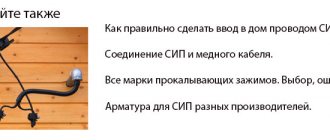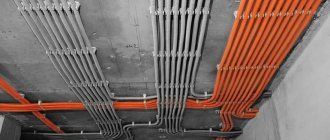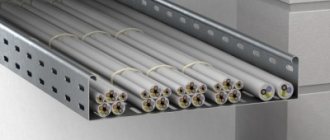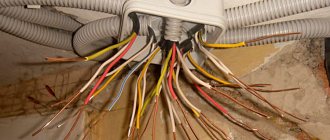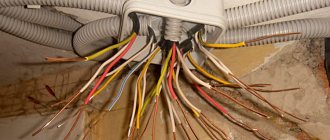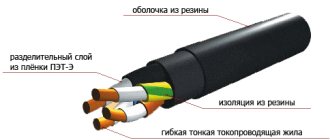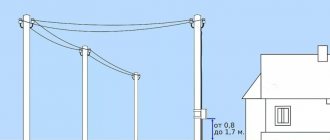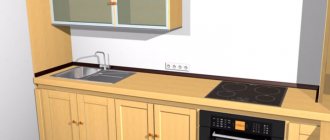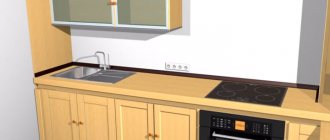Requirements for laying electrical cables are defined in the relevant regulatory and technical documents containing a complete list of procedures and measures, the implementation and adoption of which is necessary to ensure fire and electrical safety of electricity consuming facilities. In this article we will consider the main points (general rules) of the construction of indoor (indoor) and outdoor cable power lines. We will also describe some measures taken to make it possible to operate cables in various environments (conditions) - air (overhead power lines), soil, water.
Rules for laying electrical cables inside buildings
There are two main ways to lay electrical network cables inside buildings - open and hidden. The first method involves the placement of electrical wiring along the surface of walls and/or ceilings inside the building, as well as in trays, cable racks, etc. Standards for laying open electrical cables require the use of various types of mounting elements or components, such as strings, baseboards, brackets, cables, boxes , metal/plastic hoses, pipes and other fittings. Open wiring, in turn, can be stationary or mobile (non-stationary).
Basic standards for laying electrical cables in residential areas and industrial facilities (open wiring):
• Cable lines designed for voltages from 42 V must be laid at a height of 2–2.5 m above the floor level. The height is not standardized if the cable is laid in boxes, sleeves and other structures with a degree of protection of IP20. • If the cable crosses a pipeline, it should be laid at a distance of 50 mm (clear) or 100 mm (pipelines for transporting flammable gases or liquids). Moreover, if the distance is less than 250 mm, the cables must have additional protection from mechanical damage. Also, electrical wiring must be protected from high temperatures if it runs next to a heating or hot water supply system. • In places where the cable passes through walls and ceilings (from one room to another, cable output to the outside or entry into the room from the outside), it is necessary to insert pipes. • Boxes, sleeves or other structural elements are mounted in such a way that moisture cannot accumulate in them. If there are emissions of vapors, gases or dust in the premises that have a negative effect on the cable sheath, then the boxes, pipes and other elements used for laying must be sealed, and their joints must be sealed.
According to regulatory documents for laying electrical cables, “hidden” refers to electrical wiring laid directly inside the structural elements of a building - walls, ceilings, ceilings, floors. In this case, the cable can also be laid in pipes, sleeves, boxes or other installation elements laid through voids in the ceilings or in grooves created during or at any time after the construction of the building.
The standards for laying an electrical cable in this installation method require compliance with the same rules that apply to open wiring. There are also additional requirements. Firstly, when laying in boxes or other mounting elements, the same requirements must be met as for open installation. Secondly, it is prohibited to lay hidden wiring in ventilation shafts and ducts (permitted provided the cables are laid in steel pipes).
Power Wiring Splicing
Connecting power cables affects more than just safety. Although a broken live wire will cause enough trouble. A poor-quality splice can cause sparking under load, a progressive increase in resistance, and rapid heating. Despite the non-flammable insulation, this may cause a fire.
In addition, poor contact at the splice leads to loss of cable power, and the current strength may decrease.
It would seem, why use pieces of wire if you can stretch an unbroken chain. However, in reality, breaks occur (it is necessary to make an emergency splice), and the cable may simply not be enough. Therefore, the question is: “how to connect the power cable?” worries many.
There are a few simple rules:
- A cable with multiple conductors is spliced with each conductor offset. What does this mean in practice? Two (or more) connections should not be located opposite each other.
This applies to makeshift repairs (which is what you will be doing). Professional electricians splice power cables using special equipment. - In order to have a repair margin for the cable length, a loop is always left when inserting it.
- You can connect the power cable using refractory soldering, but it is better to organize a mechanical splice. For this purpose, crimp sleeves are provided.
- After connection, it is necessary to restore the insulation and outer shell. If the dielectric characteristics differ from the factory ones, the cable cannot be considered safe. Even if the resulting coupling does not look aesthetically pleasing, it can be twice as thick as the diameter of the cable. In this case, it is important to protect the connection from external influences.
Compliance with all requirements and recommendations will preserve not only electrical equipment, but also your health.
Basic requirements and standards for laying electrical cables in the ground:
• Electrical wiring is laid in a trench with a depth of 70 cm. Cable lines for voltages from 35 kV must be protected from mechanical damage by covering them with reinforced concrete slabs with a thickness of 50 mm or more. At voltages up to 35 kV, ordinary bricks laid along the route can be used. When using armored cables, a protection device is not necessary. • The minimum trench width is 25 cm. If you plan to lay several cables, the distance between them should be 10 cm (up to 1 kV), 25 cm (20–35 kV) or more (depending on the specific situation). This must be taken into account when calculating the trench width. • Before laying the cables, a sand and gravel cushion about 10 cm thick is poured onto the bottom of the trench. • If the cables do not have metal armor, it is necessary to use protective structures to prevent mechanical damage - for example, metal / plastic pipes. Protection may also be required for armored cables (depending on the type of soil, weather conditions in the region and other criteria). • Next, the cable is again covered with sand about 15 cm thick. A warning tape or cable cover plates (CCP) are laid on top of the outer cushion, which serve to inform about the presence of electrical wiring underneath them. • On top of the warning tape or PZK, soil is poured with a reserve (after some time it will settle).
Installation of cable trays
The cable tray is made of a metal profile and consists of a base with a cover into which the wires are mounted.
In addition to connecting elements, the design includes adapters, bends, turns, cross-shaped and T-shaped parts. The tray acts as a fastener for wires and cables with voltages up to 1000 Volts. The tray should not be filled with cable bundles more than 50%. Otherwise, overheating of the cables is inevitable.
The number of wires in one bundle should not be more than twelve. Wiring can be reconnected into bundles after four and a half meters when the trays are horizontal, and after about a centimeter when they are positioned vertically.
Metal trays that conduct electrical current must be grounded. An uninsulated wire or cable is extremely dangerous: it can cause electric shock. All parts of cable trays do not need to be grounded due to the fact that screw connections securely connect them to each other. It is recommended to ground the trays only in two places, in different directions of the line, and at the ends of their branches.
Air lines
Requirements and standards for laying cables along overhead power lines depend on the specific situation. Many factors are taken into account: types of cables and supports, electrical voltage, the presence of parallel/intersecting lines, weather conditions in the region, etc. The main points of the construction of overhead power lines can be given as follows: • Design features, load-bearing capacity and other physical characteristics overhead power line supports that will be used for laying electrical wiring are determined at the design stage of overhead power lines and depend on many factors - soil properties, weather conditions in the region, the type of cables used and other criteria. Compliance of the characteristics of overhead line supports with these criteria is one of the main requirements for their design and subsequent construction. • Overhead line supports should not be erected in places where their presence may interfere with the movement of vehicles and pedestrians. Otherwise, power lines are surrounded by barrier structures (baffle pipes and other structures). • When constructing overhead line supports in forest areas, cutting down plantings is not necessary. One condition must be observed here: the distance between the plantings and the lowest point of the cable sag should be 0.5 m. • Regulatory documents for laying electric cables also provide for grounding of overhead line supports and traverses.
Putting electrical wiring into operation
What is the difference: grounding and grounding
Upon completion of the entire range of electrical installation work, carried out on our own or with the involvement of a third-party contractor, their acceptance is organized by a commission consisting of representatives of local electrical networks and Energosbyt specialists. Based on the results of the inspection of the electrical wiring, the members of the commission draw up an acceptance certificate, which necessarily records all the shortcomings made by the contractor (violations of SNiP requirements) and gives recommendations for their prompt elimination.
In the absence of serious comments, as well as after eliminating all the shortcomings, the members of the commission sign an act of acceptance of this facility and its commissioning.
In conclusion, we note once again that regardless of the purpose of the electrical wiring (whether it is done for the installation of equipment or for the purpose of power supply to a certain facility), its commissioning is possible only if the contractor complies with all the regulations mentioned in the article.
Submarine lines
• Cable routes crossing and/or running along water bodies can be laid on the bottom and banks of both stable and erosion-prone soil. In the first case, the laying depth is 1 m, in the second - depending on the characteristics of the soil. • The cable must run along the bottom or along the shore of the reservoir in such a way that it does not become sagging in uneven areas. Such areas should be avoided or covered with crushed stone, pebbles or other materials. If there are obstacles along the route in the form of shallows, rock ridges, etc., the cable is laid in a previously prepared trench. • Information boards should be installed near bodies of water where cables are laid, notifying about the presence of electrical wiring under water. • Crossing cables during underwater installation is prohibited.
A large selection of electrical cables is presented on the website. After reading the product description, you can make a choice yourself or contact a company specialist who will competently advise you on issues of price and quality.
Shield installation
This is the most difficult and critical part of installing an electrical network. Circuit breakers and RCDs are installed in the panel according to the diagram that was determined earlier.
The shield includes a thick input cable from the common house bus and is routed throughout the room through intermediate devices. So, for a lighting group you can use a 16 A machine and a 25A/30mA RCD, for household appliances - a 25A machine and a 40A/30mA RCD, and so on.
Please note that the selection and arrangement of devices in the panel, as well as the final installation of the electrical panel, should only be carried out by a professional!
The shield can either be placed in a niche, if there is one, or simply hung on the wall. Please note that when making a new installation of electrical wiring in an apartment, it is also necessary to replace the input to the house, that is, the connection to the common house bus.
In this case, you will have to disconnect the old electrical wiring input from the electric meter and connect a new one, which entails the need to reseal the meter. Optionally, you can try to get the meter moved into your home, but energy supply companies do not always allow this.
